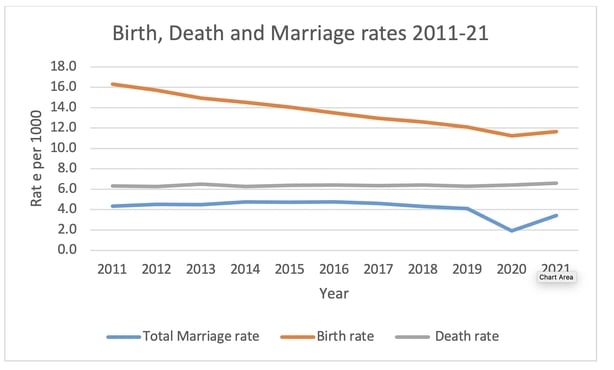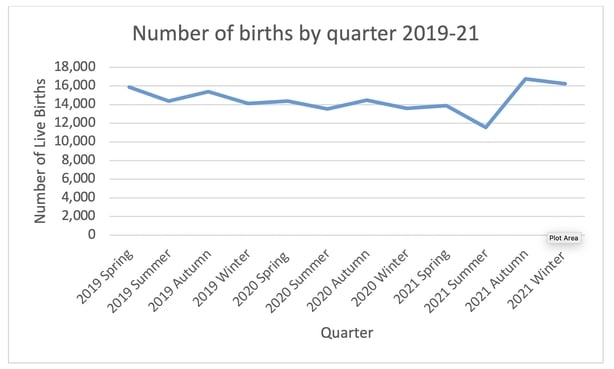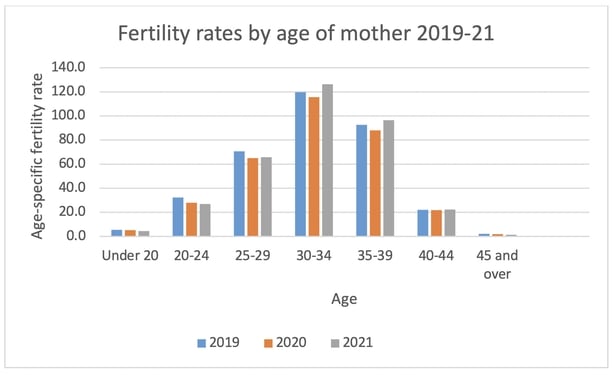Analysis: a look at the data behind post-pandemic baby boom hysteria reveals a much different picture
There appears to be mass excitement in the Irish media about a baby boom. Yes, the number of births, as well as the number of deaths and marriages, all rose in 2021 compared to the numbers in 2020. But how has the pandemic affected our lives? It is certainly not a uniform effect.
Data from the Central Statistics Office shows that there was a continuation of the decline in births in the first years of the pandemic, but the number of births rose in the latter half of 2021. Our birth numbers have shot up and down in recent decades, while our fertility rate has slowly drifted downwards. The fertility rate is the average number of children born to women of childbearing age (15 to 44 years of age), whereas the number of births is recorded as the number of live births per 1,000 of the population each year.

The total number of births is what matters for projecting future demand for childcare, schools, housing and hospitals It depends on the number of women of child-bearing age and the Total Fertility Rate (TFR). The former is the big source of variation and is volatile due the impact of net migration, but the latter also varies significantly and is more of interest from a social perspective.
One of the biggest influences on Ireland's population in the past decades has been migration. The highest number of births in the 20th century occured in 1980, at 74,064 according to CSO figures, and that fell to a low of just over 48,000 in 1994, reflecting the 1980s tide of emigration. It then reached a new peak of 75,554 births in 2009 post the economic boom. By 2021, there were 58,443 births, 2,484 more births compared with 2020, and Ireland reached a population milestone of 5.1 million people. It is the first time the population has exceeded five million since the census of 1851.
We need your consent to load this rte-player contentWe use rte-player to manage extra content that can set cookies on your device and collect data about your activity. Please review their details and accept them to load the content.Manage Preferences
From RTÉ Radio 1's Drivetime, Dr Jo Murphy-Lawless from the Centre for Health Evaluation at NUI Galway on the post-pandemic baby boom
Demographers argue that epidemics manifest a common pattern as far as their impact on population that is, a steep decline in birth rates followed by gradual increases and then followed by a baby boom. So the question is are we seeing the start of an Irish baby boom?
Fertility rates are remarkably hard to predict, but a global trend of falling fertility rates started well before Covid-19. You could expect this fall to continue given current economic conditions (the rising cost of living and the housing crisis), a mental health crisis (particularly among young adults) and a rise in precarious jobs, which have all been shown to influence future birth rates. We may therefore expect the pandemic to affect childbearing differently based on a number of these factors, but also on age.
The sex lives of the Irish: did lockdown lead to a baby boom or bust? Insights from @CarmelHannan @UL @IrishResearch - video by @_lauragaynor - read more at https://t.co/hqNnm9Xio9 pic.twitter.com/2oVYp9Y1Nk
— RTÉ Brainstorm (@RTEBrainstorm) August 31, 2021
So let’s take a closer look at fertility trends. The earliest we would have expected Covid to affect people’s decisions to become pregnant would have been February 2020, thereby influencing births on average from November 2020.
In the graph below, the number of quarterly births are plotted for the years 2019 to 2021. We have seen that the number of births had been falling before the pandemic, but they rebounded in the latter half of 2021. The total period fertility rate, TPFR, represents the projected number of children a woman would have if she experienced current age specific fertility rates while progressing from age 15-49 years. A value of 2.1 is generally considered to be the level at which the population would replace itself in the long run, ignoring migration. In 2021, the TPFR for Ireland was 1.7 which is below replacement level. The TPFR in 2020 was 1.6 so it was the first time since 2010 that this fertility rate increased year on year.

We can find out more about what's happening if we look at trends in birth rates by mother's age, that is, age-specific fertility rates. The graph below shows that the effect of the pandemic on childbearing differed by age. This finding reflects a similar trend found in England and Wales.
Fertility rates fell among women aged under 25 and continued to fall through 2020 and 2021. Fertility rates among women in their 30s did not just recover in 2021 after falling in 2020 but rather they increased. Rates for those in their early 40s have remained stable at a low level. However, compared to the UK, fertility rates at these older ages are higher in Ireland.

So how can we explain this trend? We do not have data on fertility intentions in Ireland so we cannot know the reasons and what follows is speculation. It appears that young adults were particularly affected by lockdowns, with fewer opportunities to meet people and form relationships outside of online dating sites (who have reported a boom in activity).
As I discussed in a previous Brainstorm piece, a US study found birth declines were steeper in states with more extensive reductions in mobility. In addition, increased uncertainties associated with jobs/career plans and the housing market might have deterred young couples from planning a baby. Younger women have more opportunities to postpone their childbearing in response to these uncertainties simply because they have more time to catch up on any births that had previously been put off.
The stresses of juggling work and family, rising living costs, childcare barriers, insecure work, house prices and climate change all put a damper on baby plans
On the other hand, the increased time spent together for couples in longer term relationships may have renewed a focus on their home life. It seems that the lockdowns encouraged these couples to have the child they were planning but postponing having up until now or plan to have a child they would not have otherwise had.
Will this trend continue? The stresses of juggling work and family, rising living costs, childcare barriers, insecure work, house prices and climate change all put a damper on baby plans. In the end, plans to celebrate an Irish baby boom should be put on hold. It is a matter of wait and see what the data will reveal.
The views expressed here are those of the author and do not represent or reflect the views of RTÉ




